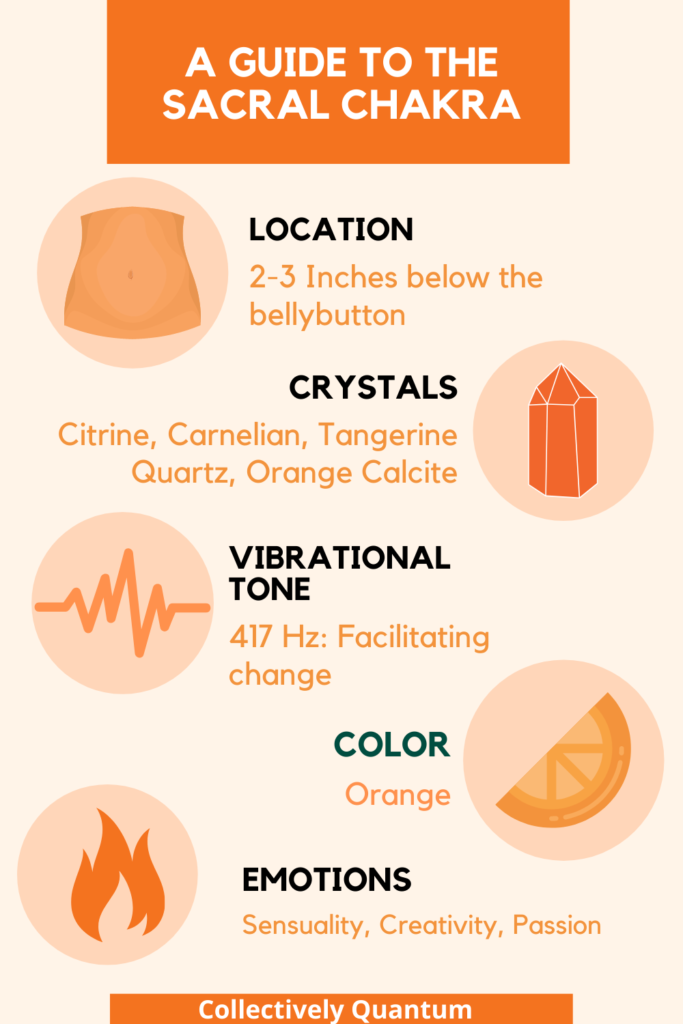
Your Chakras serve as storage centers for the energy that flows through your body. You have seven major chakras that run the length of your spine, but minor chakras are located all over your body. Each of these storage centers correlates to a specific organ/gland combo, beginning at the base of the spine and ending at the crown of your head. Because of this, the main chakras are traditionally numbered one through seven, beginning with the root chakra.
The energetic frequencies of these centers have been studied, and through a mixture of ancient wisdom and practical experience we have arrived at an understanding of how each chakra influences our energetic selves.
Although healers and mystics have recognized the chakras for thousands of years, they are just now beginning to make their way into modern medicine. If you are skeptical, check out this article.
Because of the abundant information available about each energy center, this post just skims the surface. It is written as a comprehensive guide, something that serves as a baseline for your knowledge, so that you can grow and develop from a strong foundation.
Sacral Chakra
The Sanskrit term for the sacral chakra is Svadisthana. This word comes from the stem sva, meaning ‘One’s own’, and adisthana, meaning ‘Seat’ or ‘Abode’. Roughly translated, this means the place where the self resides, or the seat of your soul.
This is really fascinating, because according to some ancient healing practices, the ‘Sea of Qi’ or ‘Lower Dan Tian’, resides in this area. Thought to be one of the main storage centers of life energy, some traditions also believe that this area is where your soul resides.
Located two inches below your navel, the sacral chakra is the center of creativity, passion, and desire.
Physical Identity
The sacral chakra sits in your low belly, about two inches below your bellybutton. Physically, this chakra governs the gonads, or sex organs, and the kidneys. As mentioned in this post, there is some controversy about whether it is the root chakra or the sacral chakra that controls the adrenals.
This chakra regulates sexual function, as well as water regulation and fluid elimination via the kidneys. In terms of the spine, the lower thoracic region, vertebrae T9-L4, corresponds to this energy center.
Emotional Identity
Emotionally, this chakra controls creativity, pleasure, and joy. The sacral chakra is the center of our sexuality and passion, although this energy can manifest as creativity and passion for work, life, hobbies, etc.
This chakra typically develops from years seven to fourteen of the human lifespan. Because of this, any trauma during this period, especially things like bullying, or other abusive behaviors towards a person’s creativity or passion, will be stored in this chakra.
Just like our mental state, our energetic state can become imbalanced. Because of the energetic nature of the chakras, they can either become overactive or underactive. The symptoms of these imbalances begin first on an emotional or mental level, then develop into physical symptoms if the imbalance is not addressed.
Emotional Symptoms
Emotional symptoms of an imbalanced sacral chakra include:
- Extreme emotional outbursts
- Depression
- Lack of creativity
- Intimacy issues
- Avoiding creative projects
- Working too much or too hard
- Struggles with addiction
- Feeling like life is too rigid
- Sexual guilt
- Aggressiveness
- Manipulation
- Either burying emotions or being highly emotional
- Oversensitivity
- Jealousy
Physical Symptoms
Physical symptoms of an imbalanced sacral chakra include:
- Infertility
- Disease in the reproductive organs
- Low back pain
- Sexual dysfunction
- Reproductive disorders
- Changes in libido
- Water retention or dehydration
- Kidney infections
- Constipation

Balanced Presentation
If your sacral chakra is balanced, you are likely to feel creative in all your endeavors, have a strong sense of self, and be comfortable in your sexuality. Because of this, other signs of a balanced sacral chakra include healthy expressions of creativity, balanced emotional responses, proper sexual and reproductive function, and regular experiences of joy and pleasure.
Although your chakras are capable of becoming both overactive and underactive, when balanced the signs and experiences will be the same. A balanced sacral chakra means that imbalanced symptoms are absent, and as a result you feel open, creative, and passionate.
Color and Vibration
The chakras are traditionally depicted with the colors of the rainbow. As the second chakra, the sacral chakra’s color is orange. However, clinical manifestations of color within the chakras vary widely based on the individual in question and their experiences.
Vibrationally, this chakra corresponds with RE on the Solfeggio sequence, and registers at 417 Hz. This is also the vibrational tone of the lunar month, and is known for undoing situations and facilitating positive change.
On the traditional musical scale, this chakra resonates with Re (as in a drop of golden sun) which is also the musical note D.
Affirmation and Aura Connection
The sacral chakra governs sensuality and creativity, and its inherent right is to feel. The common verbal expression of this is, ‘I am creative’ or ‘I am a passionate being.’
The sacral chakra’s affirmation looks something like the following:
I am connected to myself and my community. My sexuality and passion serve as fuel to my creative endeavors.
In connection with the aura, the sacral chakra corresponds to the emotional body. In Neo-theosophy, the emotional body is the subtle body above the etheric body, and is responsible for the processing and regulating the emotional state of the organism.
Balancing the Sacral Chakra
Activities that balance the sacral chakra allow you to express your creativity and passion. Because of this, some of the most well-known activities to balance the sacral chakra include:
- Dancing or Yoga
- Painting, drawing, or writing
- Wearing the color orange
- Use corresponding crystals, such as citrine, carnelian, tangerine quartz, and orange calcite
- Listen to 417 Hz, the sacral chakra vibration. For a good resource, check out this Youtube video
Conclusion
The chakras serve as energy reservoirs in the body, and, just like aspects of our physical anatomy, they also impact our health and wellness. Because of this, understanding the energetic influence the chakras have on your mental state and physical body leads to a better grasp of true health. Finding ways to balance your chakras, including your sacral chakra, will create shifts in your overall wellbeing.
If you have been feeling emotionally, creatively, or sexually unavailable, or have experienced situations that have caused you to feel like a victim or ‘less-than’, it has most likely been stored in your sacral chakra.
If any of the symptoms of imbalance resonated with you, it may be time to check in on the health and wellbeing of your second energy center. Take time to reflect on how your sacral chakra is functioning, feeling, and impacting you.
Tell me: Did this article resonate with you? How has your sacral chakra been feeling?



